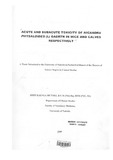| dc.description.abstract | The plant Nicandra physaloides (L) Gaertn, commonly known as the' apple of Peru' is a member
of the solaneceae family. It has been widely associated with livestock poisoning in Kenya and
elsewhere. The clinical signs reportedly associated with its poisoning are circling, tremors of the
hind limbs, tachycardia, bloat, convulsions, coma and death. In the current study the acute
toxicity was determined by intra-peritoneal injections of the aqueous extracts from different plant
parts in a total of one hundred and fifty (150) white Swiss mice aged between to and 12 weeks
and divided in groups of six (3 males and 3 females) for each dosage level. The median lethal
dose (LDso) was then calculated by the method of Reed and Muench (1938). The subacute
toxicity was determined by feeding five groups of two male Friesian calves each, aged between 8
and 10 months, at 0 (control), 4, 8, 16 and 32% levels of dried ground whole plant material in
wheat bran for 14 weeks. The physiological parameters of rectal temperature, respiration, heart
rate and ruminal motility were taken from all the calves every morning for the whole period of
the experiment. The blood for hematology (5ml in EDTA) and biochemistry (l5ml without
anticoagulant) was collected weekly via the jugular vene-puncture after thorough disinfection of
the site with surgical spirit. LDso values for the leaf, fruit and whole plant extracts were 1.82,
2.58 and 3.62 g/kg body weight respectively, therefore, classifying the plant as slightly toxic
according to Loomis (1978). The clinical signs showed by the mice were starry coat, slowed
movements, fast respiration, gasping for air and leaping into the air before collapsing. The
treated calves transiently exhibited muzzle drying, heart beat irregularity, loose feces, staggering
gaits and lower growth rate than the control group. The activity of the enzyme gammaglutamyltransferase
(GGT) and the mean corpuscular volume (MeV) were significantly lower
(P<O.05) in the treated group than in the control. There was no significant difference (P>0.05)
between the treated and control groups in respect of the other assayed hematological (total
protein. hemoglobin, red blood cells, packed cell volume, mean corpuscular hemoglobin
concentration, white blood cells, lymphocytes and neutrophils) and biochemical (aspartate
aminotransferase, creatinine and blood urea nitrogen) parameters. There were no mortalities, no
gross or histopathological lesions in all the groups. The possible reasons for the difference in
behaviour between the calves in this experiment and the suspected natural cases were thought to
be due to the variations in animal susceptibility or even plant toxin content. It is concluded that
the plant Nicandra physaloides growing around the Kabete areas of Kenya may contain toxic
phytochemicals that may cause poisoning in livestock if consumed. Nicandra physaloides is
known to contain glycosides, steroids and alkaloids from earlier studies. More studies are
necessary to determine the nature of these phytotoxins and their exact mode of action.
Meanwhile livestock keepers are advised to control this plant in their pastures and avoid its
consumption by animals. | en |

